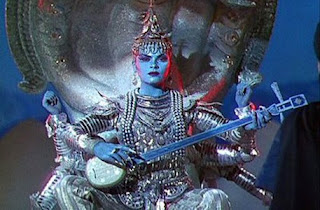(1940) Directed by Ludwig Berger, Michael Powell, Tim Whelan, Alexander Korda (Uncredited), Zoltan Korda (Uncredited) and William Cameron Menzies (Uncredited); Written by Miles Malleson; Scenario by Lajos Biró; Starring: Conrad Veidt, Sabu, June Duprez and John Justin; Available on DVD.
Rating: *****
What’s It About?
On paper, The Thief of Bagdad looked like a cinematic disaster. The film went through an astonishing six directors (three of whom, including producer Alexander Korda himself, remained uncredited). To make matters worse, the production had to be moved from England to the United States when World War II broke out. Normally, such a troubled production would have resulted in a less than perfect end product. No one would have expected that the filmmakers could pull off the unthinkable, creating one of the greatest fantasy films of all time.
Anyone who recalls Disney’s animated film Aladdin will be familiar with many of the elements in The Thief of Bagdad. Both movies drew from the well of One Thousand and One Nights (aka: Arabian Nights), taking liberties with the source material along the way. There’s a thief, a treacherous grand vizier, a genie, flying carpet, and a princess with her doddering father. As with many stories that are continually recycled and re-told, it’s not the components that make the film, but the telling.
The performances in The Thief of Bagdad are particularly memorable. Sabu devours his role as the nimble and quick-witted Abu the thief (a part that was relegated to a monkey in Disney’s version) with charm and conviction. Abu lives for adventure, and has learned to survive through trickery, coupled with physical and mental dexterity. He’s more than a match for Ahmad, when their paths unwittingly cross. He teaches Ahmad how to live on the streets, although Ahmad isn’t quite as successful at teaching Abu how to be civilized.
John Justin, in his first film role, plays Ahmad, the ruler of Bagdad. He’s shielded by the suffering of his citizens by his grand vizier Jaffar, and doesn’t realize their discontent until he walks among them. When he’s cheated out of his kingdom by Jaffar and forced into exile, he and the lowly Abu form an unlikely alliance. Amidst the woes of his exile to the neighboring city of Basra, he finds love and inspiration in the visage of the Princess (June Duprez).
Conrad Veidt is obviously having a great time as the villainous Jaffar, who betrays Ahmad and takes his place as the king of Bagdad. He lusts after the Princess, and preys on her father the Sultan’s (Miles Malleson) fondness for collecting rare and unusual toys. (Minor spoiler alert!) It’s the Sultan’s collection that ultimately becomes his undoing. Jaffar first presents him with a mechanical flying horse in exchange for his daughter. He follows up with the gift of a multi-armed, moving figure resembling the goddess Kali that’s more than she seems. As an actor, Veidt was someone who knew the face of evil, having escaped from Nazi Germany in 1933. It’s not too difficult to see how the Nazis could have influenced Veidt’s portrayal of Jaffar, as the perfect embodiment of the corruption of power. This influence would clearly play a huge part in another iconic role, two years later, as Major Strasser in Casablanca.
Rex Ingram does an amusing turn as the powerful Djinn. Trapped inside a bottle for two thousand years, he’s had a lot of time to contemplate his fate, and he’s not exactly thrilled with humankind. When the Djinn is freed from his glass prison by Abu, his first impulse is to kill his benefactor. Thanks to Abu’s trickery, however, the tables are abruptly turned. The Djinn is far from Abu’s humble servant, unhappy with his current arrangement, but bound by duty to fulfill his master’s three wishes.
Why It’s Still Relevant:
The Thief of Bagdad was nominated for four Academy Awards, and took away three: Best Art Direction, Best Cinematography and Best Effects (Miklós Rózsa’s rousing score was the fourth nomination). The special effects might seem primitive by today’s standards, but were truly groundbreaking for the time, incorporating pioneering bluescreen effects developed by Larry Butler. Many of the backgrounds were elaborate matte paintings. They’re amazing to look at, fostering an aesthetic that doesn’t strive for hyper-reality, but assembling a fantasy world -- like the pages of a picture book that came alive. At some point in the future when the inevitable remake is made, no amount of CGI landscapes and computer-animated action will be able to duplicate the magical properties of this film.
The vivid Technicolor cinematography in The Thief of Bagdad is unlike anything existing today. Color plays a huge part in setting the breezy, sweeping tone of the film. The filmmakers didn’t take color for granted, but exploited it at every turn, as seen in the brightly adorned costumes and gorgeous pastel-hued city vistas. It almost appears as if new colors were created expressly for this production.
Awards and effects aside, The Thief of Bagdad endures as one of the finest fantasies committed to film. The fact that everything works so well belies its tumultuous production. There’s an exuberance not to be found in modern movies. It’s that rare experience that completely immerses us in another world for a 106-minute vacation from our everyday lives, and it reminds us why we go to the movies.






No comments:
Post a Comment